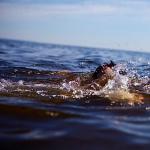As you know, in Russia the water temperature in reservoirs is low, and in winter they are also covered with ice of varying thickness depending on the time of year and air temperature. However, bodies of water are dangerous at any time of the year.
When swimming and using watercraft, the danger lies in strong currents (including underwater), deep pools and underwater cold springs. In summer, low water temperature is added to these factors. In winter, most reservoirs are covered with ice, which poses a great danger, especially after the first frost and during the thaw period. At this time, the ice is thin and there is a very high risk of falling into icy water.
It is very important to follow the rules of safe behavior on water bodies, both in summer and winter. In summer, you should not swim in unfamiliar places and especially dive into the water: at the bottom there may be snags, pieces of metal, scraps of reinforcement and other objects that can cause serious injury.
In addition, a reservoir can contain everything from very cold underwater currents to the presence of pathogens of severe infectious diseases in the water. The best place to swim is where most people swim. If no one drowns or gets sick, then everything is fine. Such places are the city beach or the village bank near the river, where all the children swim. It is dangerous to play games in water that involve diving under water for a time. An untrained person cannot stay under water for more than 1 minute. Then comes a sudden loss of consciousness. It is impossible to control this moment, therefore it is extremely dangerous.
You cannot swim far from the shore unless you are insured by a boat or motorboat. The wind may pick up or the current will be stronger than you expected, and then you may not have enough strength to go back. It should be emphasized here that under no circumstances should you drink alcohol (including beer) while swimming. It’s not for nothing that people say: “The sea is knee-deep for a drunk!” Drunk people do not measure their strength and most often drown.
If you have swam far from the shore and feel that you will not swim back, do not panic. Calm down and assess the situation. Remember that a person with full lungs of air is lighter than water and cannot drown himself. Practice near the shore: take a breath and lie on your back, balance your body, then stop moving your legs, and then your arms. You will find yourself lying quietly on the water with your nose, mouth and eyes on the surface. It is he himself who drowns a person, or rather, his fear and panic.
So, you are tired, and the shore is far away. Lie on your back and rest. Relax your arms and legs. If your nose still floods, lightly work with your palms as you dive. You can stay in this position for a long time. The only signal is hypothermia. After a few minutes, once you have regained your strength, swim further to the shore. It is better to swim breaststroke rather than crawl or strides, because... breaststroke saves strength.
Now a little about watercraft. Unless you are authorized to operate them, never drive a boat or handle the handle of a boat's outboard motor. This is the same as without a license to drive a car. Water does not forgive mistakes, but many do not understand this. In strong winds and side waves, you may be capsized. In turn, a good wave will not allow either you or your fellow travelers to swim to the shore. An overloaded boat or boat can also take on water and sink. They also have a hard time steering and you could be the victim of a large river boat that will crush your boat like a shoe would crush a cockroach. I repeat once again: water does not forgive mistakes!
What should you do if, despite all your efforts and warnings, your friend still drowns? If you are not a good swimmer, it is better not to try to save him. Then instead of one victim there will be two. If he is near the shore, throw him a rope or stick and pull him towards you. Well, if there is a boat, jump in it and sail it to him. Well, if there is nothing at hand, urgently call adults, good swimmers - they will help.
Assuming you are a good swimmer, then jump in to help. Swim up to the drowning man from behind, otherwise he will wrap his legs and arms around you and pull you along with him. Wrap your hand around the neck so that his head remains on the Surface and, raking with the other hand, drag him to the shore. Already at the shore, if he is conscious, try to push him into shallow water. Such an operation on water will require all your strength and skill. Now let’s assume the worst: you pulled your friend out, but he “drank” water and lost consciousness. The first thing to do is to clear the airways. To do this, you need to put the victim face down so that your knee is under his stomach. It’s difficult to do this alone; it’s better to work with helpers. An unconscious person is worse than a slippery heavy bag, and handling him is very, very difficult.
So, after you put pressure on his stomach with your knee, water may come out of his mouth. There are cases of bronchospasm when water does not enter the lungs, but the above procedure still needs to be done. After this, he must be placed on his back on a flat surface and his pulse and breathing checked. If they are present, it is necessary to bring the victim to his senses with light slaps on the cheeks; if they are absent, immediately begin closed cardiac massage and artificial respiration. When performing a heart massage, the palm of the right hand is placed slightly to the left of the middle of the victim’s chest, the left palm is pressed on top and rhythmic movements are made with sharp pushes of both hands. There is no need to be very zealous, because... You can break your ribs.
At the same time, artificial respiration is performed. It can be done using the mouth-to-mouth method, or it can be done by spreading it to the sides and pressing the arms (or legs) of the drowned person to the body. With the mouth-to-mouth method, you take in lungfuls of air and blow it into the victim's mouth. The air comes out spontaneously. During these procedures, it is necessary to monitor the victim’s tongue. It may sink, and then your efforts will be in vain. Therefore, you need to take your tongue by the tip with a handkerchief and keep it in sight. The pace of work should be as follows: for 6 rhythmic movements of the heart, 1 artificial respiration. This work, as a rule, is difficult, long, and sometimes requires superhuman efforts, especially if resuscitation measures are carried out by one person. Unfortunately, the author of these lines had to find himself in such a situation, and this resulted in physical fatigue of all muscles for literally a week. Resuscitation must be continued until the victim has a pulse and breathing or until obvious blue (cadaveric) spots begin to appear on the body. But in case of any development of events, it is necessary to immediately take measures to call professional ambulance doctors and rescuers. They have significantly more resources and experience to save your comrade.
Now, having dealt with summer swimming, let’s move to winter and see what we should do on reservoirs when they are covered with ice. The basic rules of conduct here are as follows. Ice that has a bluish or greenish tint is considered reliable; therefore, ice with a yellowish tint is dangerous. Also considered dangerous are areas of ice near steep banks where small rivers and streams flow into the river and at sharp bends of the riverbed. The washouts are immediately visible. Usually in this place the water comes out on top of the ice. It is best to cross bodies of water on ice during daylight hours and with good visibility. It is better to carry the backpack on one shoulder. Then, if necessary, it is easy to reset. When moving on ice, a group of people must maintain a distance of at least 5 m.
If you are not careful and still fall through, you need to lean on the ice, put one foot on it, then pull out the other, roll onto a hard surface and carefully move away from the dangerous place. Before doing this, it is better to take off your shoes. You need to leave in the same direction from which you came. If the current quickly pulls you under the ice, open your eyes and look where it is brighter. This is where you need to swim. Once you've managed to get out, be aware of the risk of frostbite, but we'll talk about that in another chapter. If you have to cross a water obstacle on ice in a car, keep the doors slightly open so that you can immediately leave the sinking vehicle.
Safe behavior on bodies of water in various conditions. Rules for safe behavior on reservoirs at different times of the year
Our country has a large number of reservoirs where you can relax in the summer or go winter fishing. Relaxing on the banks of a river or lake is wonderful, but a huge number of people die on the water every year.
Most often this happens during bathing, especially in places that are not intended for this. In winter, when the water is covered with ice, some still manage to fall under it. This is why it is so important to know what safe behavior is on bodies of water under various conditions.
Rules of conduct on reservoirs in the summer
It is impossible to imagine a summer vacation without a trip to the sea, river or pond. When the sun is hot, you really want to take a dip in the cool water. In hot weather there are especially many vacationers near water bodies. It is very important that before going on such a vacation you remember about safe behavior on bodies of water in various conditions. A document that reflects all the rules of behavior on the water should be in every administration and rescue organizations. Fresh air and water are excellent hardening factors, but we must not forget about the danger that may await you in open bodies of water.
There are some recommendations that relate to swimming:
- Some diseases may be a contraindication to swimming, so consult your doctor before going to the river or sea.
- The best time to take water procedures is 9-11 am and 17-19 pm.
- You should not swim if you have just eaten, an hour and a half should pass.
If you know how to swim, then this is to some extent a guarantee of your safety on the water, but there are cases when excellent swimmers find themselves in extreme situations and die. Therefore, it is especially important to follow safety rules for all categories of citizens.
Rules for safe behavior on the water
Safe behavior on bodies of water in various conditions must be strictly observed - this is the guarantee of your excellent vacation without incidents. After you arrive at a river or lake, after spending a lot of time on the road in a hot car, you should not immediately rush into the water. You need to rest a little, calm down and cool down, only after that you can go swimming.
To prevent your holiday from being overshadowed by unexpected situations, follow these simple rules:
- It is best if you take water procedures in places that are specially equipped for this.
- If you come to this place for the first time, before a full swim you need to examine the bottom for snags, glass and any debris.
- Do not dive in unfamiliar places, otherwise you may bury your head in the ground, snags or concrete slab.
- If on the shore of a reservoir you find a sign that swimming in this place is prohibited, then you should not risk your health, it is better to go to another beach.
- At sea, rescue services usually install buoys that you can’t swim behind; you don’t need to show your courage and compete with friends, this can be dangerous.
- If you like to play games in the water, then be careful: do not grab each other’s arms or legs, you can swallow water in the excitement and lose consciousness.
- If your leg cramps in the water, you need to call for help.
- Do not go into the water while drunk, it can end tragically.
For some reason, not everyone follows these simple rules, which then leads to accidents.
Behavior during unexpected situations
An unexpected situation can happen to anyone on the water if safe behavior on water bodies in various conditions is not observed. Your life or your friends will depend on your actions at this moment.
When swimming in rivers, it may happen that you caught in a whirlpool
. You need to put aside panic, take a lot of air into your lungs, dive under the water and try, using movements with your arms and legs, to swim away from the funnel. If you do everything correctly and, most importantly, calmly, then you will be able to get out of it easily.
Another situation that occurs quite often is swimming across a river or lake for a bet
. You may simply miscalculate your strength; it is impossible to predict how your body will behave under such overload. If you know how to relax on the water, lying on your back, then it’s not so bad, you may be able to win the argument.
The ability to rest may also be useful to you if my leg cramped in the water
. This is very dangerous, because no one can quickly help you at a great distance from the shore; you can only rely on yourself. For such cases, always take a pin with you; they say it is a good remedy for cramps in the water.
Safety of children on water bodies
The rules for safe behavior on bodies of water at different times of the year are also relevant for children. In the summer, it is impossible to keep our kids away from the water; all sorts of prohibitions do not work, so it is necessary to strictly follow the following recommendations:
- You can swim with children only in places specially equipped for this.
- Do not leave your child unattended, even if he is just playing on the shore.
- Don't let children dive.
- After a long stay in the heat, you must enter the water slowly, otherwise breathing may stop due to a sharp temperature change.
- Try to learn to distinguish your children among a large number of children, believe me, this is not at all easy to do.
- The duration of stay in the water depends on the age of the child, but it should be much less than for adults.
- Do not allow children to swim in places where motor boats and speedboats ply, and you should not do this yourself.
Keeping track of children while swimming is quite difficult, especially if there are a lot of them, as, for example, in camps. Therefore, for safety reasons, swimming is prohibited in many health centers to prevent accidents.
Rules for swimming children in open water
Water procedures for a child are very good and healthy, but the main thing is that it is safe. Since many people relax with their parents on the banks of rivers and lakes, or go “savages” to the sea, it is worth considering some universal rules:
- A child can go into the water if it has warmed up to 22 degrees, and outside it is at least 25 degrees.
- It is better to swim in the morning.
- During the first swim, 2-3 minutes of staying in the water is enough.
- Do not plunge your child's head into water.
- After leaving the water, you need to dry your body well and rest.
Relaxing on the river bank is a great opportunity to improve your health and get a lot of positive emotions. The main thing is to choose the right bodies of water. The conditions of water bodies differ at different times of the year, and this must be taken into account.
Behavior on reservoirs in winter
It would seem that winter has come, ice has frozen all the rivers and lakes, and you can safely skate and play hockey. But it is worth saying that the rules of safe behavior on reservoirs in winter must also be observed.
Here are a few rules that will help you preserve your life and health on the pond in winter:
- Ice at least 7 centimeters thick can support one person.
- Near various drains, the ice is usually not too strong.
- Do not test the strength of the ice by kicking it.
- If you are moving along a frozen body of water, then it is better to follow an already trodden path.
- When you walk in a group, the distance between you should be 5-6 meters, especially if the area is unfamiliar.
- It’s better to carry a backpack on one shoulder, so that in an emergency you can use it as a handy tool.
- If this happens and you fall through the ice, then spread your arms wide and hold on to the edges of the ice so as not to go under it headlong. Without panic, slowly get out of the hole, crawling with your chest and pulling out your legs one by one.
Dear residents!
Be careful on ponds in winter! Failure to comply with safety rules at water bodies in the autumn-winter period often causes death and injury to people.
Autumn ice is fragile before the onset of stable frosts. Strengthened by the evening or night cold, it is still able to withstand a small load, but during the day, quickly heating up from seeping melt water, it becomes porous and very weak, although it retains its thickness. The main condition for a person’s safe stay on ice is that the thickness of the ice matches the applied load.
Safe ice thickness:
- for one person - at least 7 cm;
- for the construction of a skating rink - at least 12 cm;
- for crossing on foot - at least 15 cm;
- for the passage of cars - at least 30 cm.
Time of safe stay of a person in water:
- at a water temperature of 24°C, the safe stay time is 7-9 hours,
- at a water temperature of 5-15°C - from 3.5 to 4.5 hours;
- a water temperature of 2-3°C turns out to be fatal for humans after 10-15 minutes;
- at a water temperature of minus 2°C, death can occur in 5-8 minutes.
Rules of conduct on ice
1. You cannot go out on the ice in the dark or in poor visibility (fog, snowfall, rain).
2. When crossing the river, use ice crossings.
3. You cannot test the strength of ice by kicking it. If, after the first strong blow with a log or a ski pole, even a little water appears, this means that the ice is thin and cannot be walked on. In this case, you should immediately follow your own trail to the shore, with sliding steps, without lifting your feet from the ice and placing them shoulder-width apart so that the load is distributed over a larger area. The same is done in case of warning cracking of ice and formation of cracks in it.
4. When forced to cross a body of water, it is safest to stick to the beaten paths or follow an already laid ski track. But if they are not there, then before descending onto the ice you need to carefully look around and outline the upcoming route.
5. When crossing a pond in a group, it is necessary to maintain a distance from each other (5-6 m).
6. It is better to cross a frozen river (lake) on skis, while unfastening the ski fastenings in order to quickly remove them if necessary; Hold ski poles in your hands without looping them around your hands, so that in case of danger you can immediately throw them away.
7. If you have a backpack, hang it on one shoulder, this will make it easy to free yourself from the load in case the ice falls under you.
8. When going to a frozen pond, you need to take with you a strong cord 20-25 meters long with a large blind loop at the end and a weight. The weight will help to throw a cord to a friend who has fallen into the water; The loop is needed so that the victim can hold on more securely by threading it through the armpits.
9. Children should not be allowed on the ice (fishing, skiing or skating) without supervision.
10. One of the most common causes of tragedies on reservoirs is alcohol intoxication. Drunk people react inadequately to danger and become helpless in the event of an emergency.
Tips for anglers
1. It is necessary to know well the body of water chosen for fishing in order to remember where its depth is no higher than a person’s height or where from a deep place you can quickly get to the shallows leading to the shore.
2. It is necessary to know about the conditions of formation and properties of ice during different periods of winter, to distinguish the signs of dangerous ice, to know the precautions and to constantly observe them.
3. Determine the route from the shore.
4. Descend from the shore carefully: the ice may not be tightly connected to the land; there may be cracks; there may be air under the ice.
5. Do not go out onto dark areas of ice - they warm up faster in the sun and, naturally, melt faster.
6. If you are going in a group, the distance between skiers (or pedestrians) should be at least 5 meters.
7. If you are skiing, check if there is a ski track nearby. If not, and you need to lay it, unfasten the ski mounts (in order to quickly get rid of them, as a last resort), carry the ski poles in your hands, do not put the loops of the poles on your hands.
8. Hang the backpack on one shoulder, or even better, drag it on a rope 2-3 meters behind.
9. Check each step on the ice with a pointed ice pick, but do not hit the ice in front of you with it—it’s better from the side. If after the first blow the ice breaks through, immediately return to the place from which you came.
10. Do not come closer than 3 meters to other anglers.
11. Do not approach those places where there are frozen driftwood, algae, and air bubbles in the ice.
12. Do not walk near a crack or on an area of ice separated from the main body by several cracks.
13. Quickly leave the dangerous place if water begins to flow like a fountain from the broken hole.
14. Be sure to have rescue equipment with you: a cord with a weight at the end, a long pole, a wide board.
15. Have something sharp with you that could be used to secure yourself to the ice in case you fall through and there is no way to get out without support (knife, hook, large nails)
16. Do not make many holes near you, do not make holes on crossings (paths).
Assisting someone who has fallen through the ice
Self rescue:
- Don't panic.
- There is no need to flounder and lean your whole body on the thin edge of the ice - it will break off under the weight of your body.
- Spread your arms wide to avoid diving headlong into the water.
- Rest your elbows on the ice and, bringing your body into a horizontal position, try to throw the leg that is closest to its edge onto the ice, turn your body to pull out the other leg and quickly roll out onto the ice.
- Without sudden movements, crawl as far as possible from the dangerous place in the direction from which you came;
- Call for help;
- When holding yourself on the surface of the water, try to expend a minimum of physical effort on this. (One of the reasons for the rapid decrease in body temperature is the movement of the heated layer of water adjacent to the body and its replacement with a new, cold one. In addition, during movement, the additional insulation created by the water that has soaked the clothes is broken).
- While afloat, you should keep your head as high above the water as possible. It is known that more than 50% of all heat loss in the body, and according to some data, even 75% comes from it.
- You can actively swim to the shore, raft or boat if they are at a distance that will take no more than 40 minutes to overcome.
- Having reached the watercraft, you must immediately undress, wring out the wet clothes and put them on again.
If you are providing assistance:
- Approach the hole very carefully, it is better to crawl on your bellies.
- Tell the victim by shouting that you are going to help him, this will give him strength and confidence.
- 3-4 meters away, give him a rope, pole, board, scarf or any other means at hand.
- It is unsafe to give a hand to the victim, since by approaching the ice hole, you will increase the load on the ice and not only will not help, but you yourself risk falling through.
First aid for drowning:
- Move the victim to a safe place and warm him up.
- Turn the drowned person face down and lower the head below the pelvis.
- Clear your mouth of mucus. When gag and cough reflexes appear, achieve complete removal of water from the respiratory tract and stomach (you cannot waste time removing water from the lungs and stomach if there is no pulse in the carotid artery).
- If there is no pulse in the carotid artery, perform external cardiac massage and artificial respiration.
- Deliver the victim to a medical facility.
Warming the victim:
- The victim must be covered in a place protected from the wind, well wrapped in any available clothing and a blanket.
- If he is conscious, give him hot tea or coffee. Very effective are heating pads, bottles, flasks filled with hot water, or stones heated in the flame of a fire and wrapped in cloth; they are applied to the sides of the chest, to the head, to the groin area, and under the armpits.
- You cannot rub the body or give alcohol, as this can cause serious harm to the body. Thus, when rubbed, cooled blood from the peripheral vessels will begin to actively flow to the “core” of the body, which will lead to a further decrease in its temperature. Alcohol will have a depressant effect on the central nervous system.
With the onset of the long-awaited summer, hundreds of people flock to the reservoirs to relax. Water is a good friend and ally of a person, helping to get maximum pleasure from relaxation and improve health. But at the same time, it does not tolerate frivolity and can be a source of increased danger. The consequences of frivolous behavior will be the most severe. To avoid them, every person should know basic water safety rules.
Causes of water accidents

You can identify a drowning person by the following signs:
- The head is deep in the water, the mouth periodically disappears and appears above the surface. A drowning person cannot call for help, only breathe in and out.
- The mouth is half-open or open, the head is thrown back strongly.
- The eyes become glassy and lose the ability to focus.
- Vertical body position.
- Difficulty and rapid breathing.
- A person is floundering in place, not floating anywhere.
- Attempts to roll over onto your back and assume a horizontal position are unsuccessful, while the drowning person tries to climb out of the water as if using a rope ladder.
If at least one of the listed signs is present, you need to ask the person if everything is okay. If he doesn't answer, it most likely means the person needs help. The main thing in this case is not to waste time.
Rescue of a drowning man
Water safety precautions say that the most correct thing to do is to call for help from rescuers or people who know how to swim well. But if the situation is such that you have to save someone in distress alone, these recommendations will help you do everything right:
- First of all, you should try to calm the drowning person, let him know that help is close. Sometimes this is enough for a person to stop panicking and swim to shore.
- The most effective method of rescue is to extend a long pole or rope from a boat or from the shore to a drowning person, which he can grab onto and swim out. If there is a life preserver, you need to throw it.
- It is best to swim up to a person in distress from behind, since a drowning person instinctively grabs his rescuer and fetters his movements, and can even involuntarily stun him with a strong blow.
- You need to turn the person on his back and swim with him to the shore. If he resists and thereby drags the rescuer to the bottom, you can dive into the water with him for a few seconds, this will help free you from the convulsive grip of the drowning person.
- If a drowning person goes to the bottom, the rescuer must dive, take the drowning person under the armpits or hair under the water and, pushing off strongly from the bottom, float to the surface with him.

First aid
Providing first aid to a drowned person should be done right on the shore and as quickly as possible, since death from drowning usually occurs within 5-6 minutes. The method of providing first aid depends on the state of the drowned person.
If the victim is conscious, you need to remove all his clothes, dry him and wrap him in something dry and warm. In order for all the water to leave the lungs, it is necessary to induce vomiting by irritating the root of the tongue. After the lungs are free of water, it is advisable to give the victim a warm drink.
If the drowned person is unconscious but breathing on his own, he is given ammonia to sniff, then the whole body is vigorously rubbed. After consciousness returns, the lungs are cleared of water through vomiting. The victim must be taken to the hospital, especially if there is bluishness of the skin.
If a person removed from the water shows no signs of life, first of all he needs to clean his mouth. Then the rescuer must turn the victim onto his stomach through his leg bent at the knee so that the victim’s head is below the stomach and lungs. The rescuer then presses rhythmically on the back until water drains from the mouth and nose. Manipulations to remove water should take no more than 10-15 seconds, then you should immediately begin removing fluid from the respiratory tract.
To remove water from the lungs, the victim is turned over on his stomach and given mouth-to-mouth artificial respiration in combination with closed cardiac massage. After the person regains consciousness, he must be warmed up and immediately taken to the hospital for subsequent intensive care.
Signs of effectiveness of resuscitation measures
A set of measures to revive a drowned person can be considered effective if his skin turns pink, his pupils constrict, and with massage shocks the pulse in the carotid artery is clearly felt. Revival of the victim should last until the person is able to breathe on his own. This can last several minutes, and sometimes several hours, until the ambulance arrives.
Swimming in an open pond or pool is an excellent health procedure, from which, with the right approach, you can get a lot of positive emotions for both children and adults. But water safety rules must be strictly observed, because the price to pay could be your own life or the life of a loved one.


Reservoirs are dangerous at any time of the year. In summer they are dangerous when swimming and using watercraft. The danger most often comes from strong currents (including underwater), deep pools and underwater cold springs. In spring, autumn and winter, low water temperature is added to these factors. In winter, most water bodies are covered with ice, which is a source of serious danger, especially after the first frost and during the thaw period. At this time, the risk of falling through the ice is very high.

It is important to follow the rules of safe behavior on winter reservoirs. The main ones of these rules are as follows: ice that has a greenish or bluish tint is reliable, and yellowish ice is dangerous; areas of ice are dangerous at the confluence of rivers and streams, near steep banks, at sharp bends of the riverbed; places where water appears on top of the ice pose a great danger, as they usually indicate the presence of a gulley; You should cross a body of water on ice during daylight hours and in good visibility; when moving on ice a group of people must maintain a distance of approximately 5 m;

If you have a backpack, it is necessary to provide for the possibility of quickly releasing it (it is better to carry it on one shoulder). Having fallen, you need to lean your elbows on the ice, put one foot on it, then pull out the other, roll onto the ice and carefully move away from the dangerous place. Before doing this, it is better to take off your shoes.


















